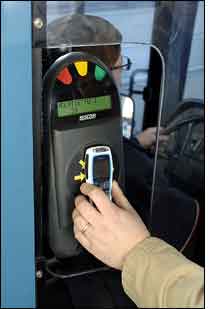Dec 23, 2005Extending the work to meld mobile phones and smart card applications, transportation applications provider Buscom has begun trials of an upgrade to its fare collection system, intended to allow bus passengers to use their own mobile phones instead of transit smart cards.
The trial, set to last until next summer, has begun with 10 Buscom employees receiving Nokia 3220 phones equipped with Nokia-provided shell enabled for near-field communication (NFC). The NFC tags embedded in shell connect to a new application loaded onto the handset. This allows users to pay for travel on any of eight specially prepared buses operating on two bus routes in the Finnish city of Oulu, where Buscom has its headquarters.
The Nokia phones will use NFC, which operates at 13.56 MHz, to communicate with existing but upgraded smart card interrogators (readers) installed on the bus. According to Buscom, the hardware upgrade allows the readers to recognize the NFC phones' data format. This format differs from that used by the Buscom smart cards currently being used by the Oulu bus system, which is operated by Koskilinjat.
According to Buscom, using mobile phones in place of smart cards for public transport can bring many benefits to transportation companies and their passengers. "Big cities spend millions and millions of dollars on their sales and distribution networks, as well as on smart cards and paper tickets," says Buscom's managing director, Kauko Suhonen. "Using mobile phones could cut a lot of that expense." For bus customers, the technology would bring several benefits that smart card systems cannot deliver. They could use the phone's Internet connection to pay for a ticket and load it into the device, for example, and they could also use the phone's display screen to check ticket balance and usage, and other data.
Currently, Buscom reports, trial passengers load prepayments onto their mobile phones by visiting an NFC-equipped ticket office. Even in the planned commercial system, such a visit would be necessary for the first payment, and to install the required application onto the phone. Starting in March, however, when up to 30 phones will be equipped to use the new payment system, the trial will add the option for a participant to use a phone's Internet connection to buy travel credit. The payment will be made either by deducting from the passenger's bank account or by credit card.
Buscom says its system already works, and that the trial's purpose is to determine how best to handle exceptions and real-life problems such as phones that are lost or have dead batteries. In Paris, French wireless telecom company Bouygues Telecom and the city's public transportation authority, Régie Autonome des Transports Parisiens (RATP), are planning a similar trial. However, they decided against using NFC communications between phones and readers, in part over concern that NFC transmissions can not be supported when a phone is without power (see Paris Transit to Test Phones as Fare Cards). A number of other companies, though, are testing out NFC-enabled phone payments, in such cities as Atlanta, in the United States (see Sports Fans Use RFID to Pay and Play), and Caens, in France (see French NFC Payment Trial Kicks Off).
Buscom notes it has yet to determine what part, if any, wireless phone services providers would play in delivering its planned service. "We have no defined role for a wireless operator yet," he says. "They want to get involved in this kind of application, but we will have to wait and see how they will."
The company plans to sell transit operators just its NFC-capable readers or reader upgrades, its ticketing system and the application required on the mobile phones. Buscom says its smart card bus transportation application and hardware are installed in 70 cities across Europe, including Turku and Helsinki in Finland, as well as towns in Denmark, Hungary and Germany.


